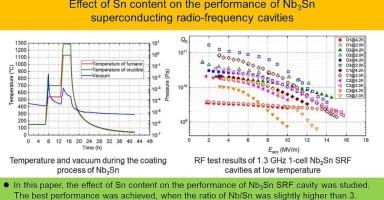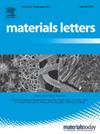Effect of Sn content on the performance of Nb3Sn superconducting radio-frequency cavities
IF 2.7
4区 材料科学
Q3 MATERIALS SCIENCE, MULTIDISCIPLINARY
引用次数: 0
Abstract
Research of Nb3Sn superconducting radio-frequency (SRF) cavities was carried out at the Institute of High Energy Physics Chinese Academy of Sciences (IHEP), in order to improve the intrinsic quality factor (Q0) and accelerating gradient (Eacc). Various recipes of coating were attempted at SRF cavities and samples made of Nb, which resulted in different Sn content. It was found that the Sn content, namely the ratio of Nb/Sn, had great influences on the performance of Nb3Sn SRF cavities. When the ratio of Nb/Sn was slightly higher than 3, the Nb3Sn SRF cavities showed the best performance during the vertical test. Q0 of 1.3 GHz 1-cell Nb3Sn SRF cavity (the ratio of Nb/Sn ≈ 3.16) reached 3.0 × 1010 (@ 4.2 K) and 1.0 × 1011 (@ 2.0 K) at low RF field. This study could provide insights on the effects of Sn content on the performance of Nb3Sn SRF cavities, which be referenced by the SRF community.

锡含量对 Nb3Sn 超导射频空腔性能的影响
中国科学院高能物理研究所(IHEP)对 Nb3Sn 超导射频(SRF)空腔进行了研究,以提高其内在品质因数(Q0)和加速梯度(Eacc)。在 SRF 晶洞和 Nb 样品上尝试了不同的涂层配方,从而产生了不同的 Sn 含量。研究发现,锡含量(即铌/锡比例)对铌-3-锡 SRF 型腔的性能有很大影响。当 Nb/Sn 的比例略高于 3 时,Nb3Sn SRF 谐振腔在垂直测试中表现出最佳性能。在低射频场下,1.3 GHz 1 芯 Nb3Sn SRF 腔的 Q0(Nb/Sn 比率≈ 3.16)达到 3.0 × 1010(@ 4.2 K)和 1.0 × 1011(@ 2.0 K)。这项研究有助于深入了解锡含量对 Nb3Sn SRF 腔体性能的影响,可供 SRF 界参考。
本文章由计算机程序翻译,如有差异,请以英文原文为准。
求助全文
约1分钟内获得全文
求助全文
来源期刊

Materials Letters
工程技术-材料科学:综合
CiteScore
5.60
自引率
3.30%
发文量
1948
审稿时长
50 days
期刊介绍:
Materials Letters has an open access mirror journal Materials Letters: X, sharing the same aims and scope, editorial team, submission system and rigorous peer review.
Materials Letters is dedicated to publishing novel, cutting edge reports of broad interest to the materials community. The journal provides a forum for materials scientists and engineers, physicists, and chemists to rapidly communicate on the most important topics in the field of materials.
Contributions include, but are not limited to, a variety of topics such as:
• Materials - Metals and alloys, amorphous solids, ceramics, composites, polymers, semiconductors
• Applications - Structural, opto-electronic, magnetic, medical, MEMS, sensors, smart
• Characterization - Analytical, microscopy, scanning probes, nanoscopic, optical, electrical, magnetic, acoustic, spectroscopic, diffraction
• Novel Materials - Micro and nanostructures (nanowires, nanotubes, nanoparticles), nanocomposites, thin films, superlattices, quantum dots.
• Processing - Crystal growth, thin film processing, sol-gel processing, mechanical processing, assembly, nanocrystalline processing.
• Properties - Mechanical, magnetic, optical, electrical, ferroelectric, thermal, interfacial, transport, thermodynamic
• Synthesis - Quenching, solid state, solidification, solution synthesis, vapor deposition, high pressure, explosive
 求助内容:
求助内容: 应助结果提醒方式:
应助结果提醒方式:


